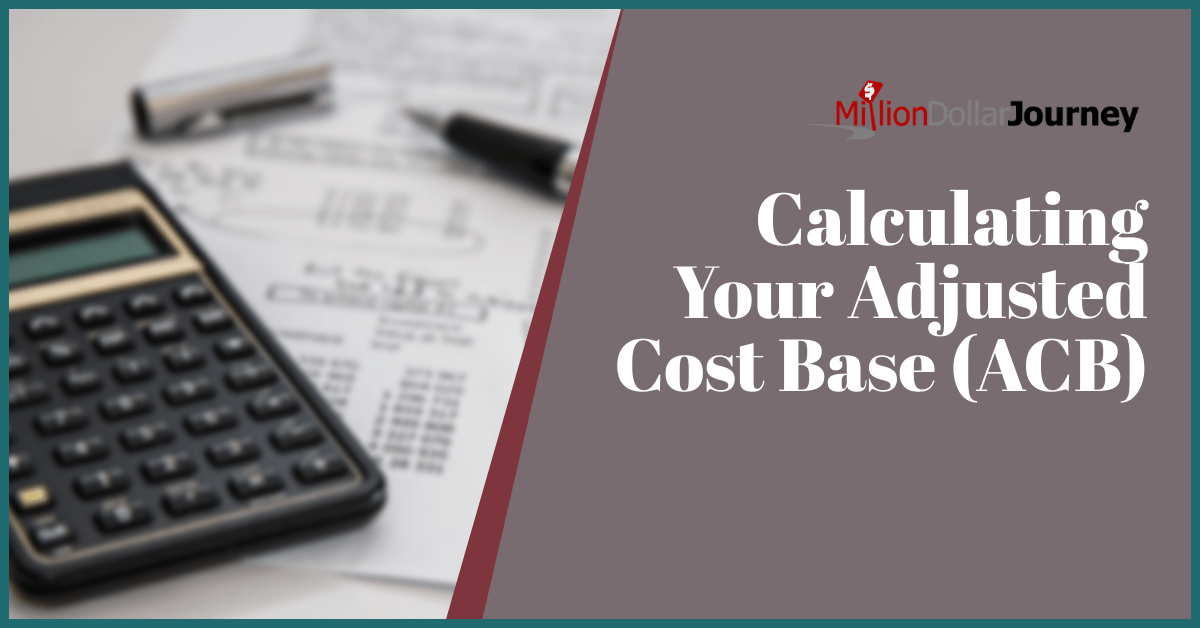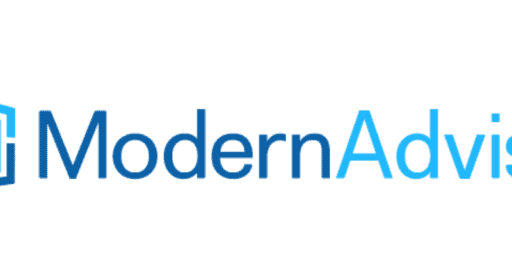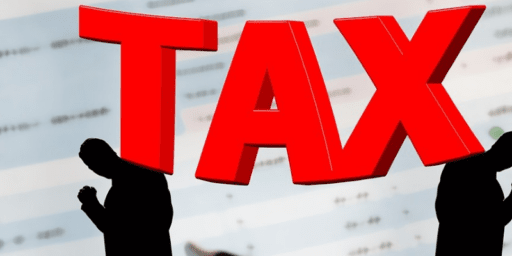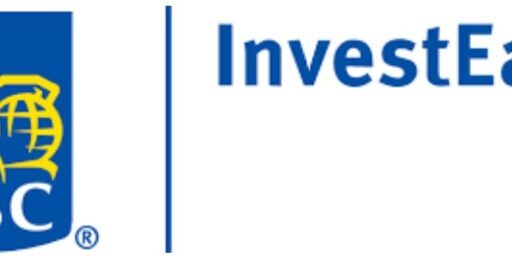Calculating Your Adjusted Cost Base (ACB)
If you’ve invested in a non-registered portfolio you’ve likely come across the tax-preparation question: How to calculate your adjusted cost base (ACB).
It’s certainly a pain in the portfolio, and can be tedious and complicated at times. But it’s a necessary ‘evil’. You need to know your ACB in order to calculate the capital gain (or loss) for tax purposes when you sell a security. The ACB only matters for non-registered investments; for registered accounts (such as your RRSP or TFSA) it’s irrelevant because there are no capital gains taxes.
Here’s the definition of the adjusted cost base courtesy of Revenue Canada.
“The cost of a property plus any expenses to acquire it, such as commissions and legal fees.”
Yes, the commissions and fees can increase your average cost base. But then you are allowed to deduct those fees when calculating the capital gains.
Calculating the adjusted cost base (ACB) of a security isn’t the sexiest of investment topics, but knowing how to do it will make you a more informed investor. We strongly suggest that you make the tracking of your ACB a regular investment task. You do not want to have the added stress of going back through countless records at tax time. Paying taxes and doing tax preparation sucks enough on its own, you don’t need the added stress at tax time.
How to Determine Your Adjusted Cost Base (ACB)
Most investors don’t acquire all of their shares in one transaction; they buy them over time and at different prices. As a result, their average cost changes.
In most cases, tracking such changes isn’t a big deal. To calculate your ACB, simply add up all of the money you invested to acquire the shares. If you divide the total sum by the number of shares, you get your ACB per share.
For simple buys and sells, calculating the ACB and capital gain is straightforward. For example, say you bought 100 shares of XYZ Corp. at $30 each and paid a commission of $10. Your ACB would be $3,000 (100 times $30) plus $10, or $3,010.
If you later sold all 100 XYZ shares for $40 each, with a $10 commission, your proceeds would be $4,000 (100 times $40) less $10, or $3,990. Your capital gain would be $3,990 minus $3,010, or $980. (Notice that the commission increases the ACB, but reduces the sale proceeds.)
Calculating Your Adjusted Cost Base With Multiple Purchases
Go to your records and find the transaction details to do an adjusted cost base calculation.
After figuring out the ACB, calculating capital gains is quite straight forward from there.
For example:
- May 2015: bought 100 shares of xyz @ $50
- Jan 2018: bought 200 shares of xyz @ $60
- Dec 2019: sold 100 shares of xyz @ $75
- Assume trade commissions are $10 each (see the discount brokerage comparison)
What is your capital gain?
First you need to figure out your average buy price or Adjusted Cost Base (ACB) or Cost Basis of the stock.
- ACB = (Total Cost + Commissions)/Total Number of Shares Owned
- ACB = [(100 x $50) + (200 x $60) + 20]/ 300
- ACB = $56.74 / share
Next we’ll calculate the Capital Gain (loss) of the transaction:
- Capital Gain (loss) = (Sell Price – ACB) x number of shares sold – commissions
- Capital Gain = ($75 – $56.74) x 100 – $10 = $1,816
- Capital Gains Tax = Capital Gains x 50% x Marginal Rate
It is a straight-forward but necessary calculation if you add to or trade stocks in your non-registered account. I think the easiest way to do these calculations is either through a program like MS Money, Quicken, or through a simple spreadsheet to track your trades.
Adjusting the ACB after you sell shares.
When a sale transaction occurs, the new total ACB must be reduced from the previous total based on the number of shares that are sold. We will have a new total ACB and a new share count.
New Total ACB After a Sell Transaction = [Previous Total ACB] – ([ACB per Share] x [Number of Shares Sold])
Here’s a simple example.
- Purchase 100 shares at $75 – $10 commission – 100 share count.
- Sell 50 shares at $100 – $10 commission – 50 share count.
Original ACB is $7500 + $10 for a $760 total with a share count of 100.
ACB per share is $75.10
Total ACB after sale. The capital gain does not affect the ACB per share, that is a separate tax event.
$7510 x (100 shares – 50 shares) / 100 shares) = Total ACB of $3755
ACB per share is still $75.10 but it is now based on 50 shares and that new Total ACB.
The ACB after the purchase.
50 shares at $125 + $10 = $6260 – new share count of 100.
Total ACB is now $6260 + $3755 = $10,015
ACB per share is now $10,015 / 100 = $100.15
What about those wonderful DRIP programs?
Those automatic dividend reinvestment programs can be advantageous, but they can increase the complexity. Here’s how regular and synthetic dividend reinvestment programs (DRIP) work.
You’re adding additional share purchases with every dividend payment. You may also be taking advantage of additional shares courtesy of the company’s DRIP discount program. And of course this DRIP may occur in concert with any regular purchases. Be prepared to stay on top of the ACB for these stocks, from the get go, and on a regular basis.
When a reinvested distribution occurs, it’s best to think of it as 2 separate transactions:
- You receive a cash distribution
- You purchase additional shares/units using the cash
When you receive additional shares via that DRIP, it creates a dollar value of reinvestment that you can use to recalculate your ACB.
The new ACB = the previous ACB and factors in the total reinvestment value.
(Previous ACB) + ((Additional Shares Received) x (Cost Per Share of Additional Shares Received))
For example if you received 3.5 shares at $57 stock price, the total transaction value is $193.80.
You’ll find many great DRIP candidates among the Canadian Dividend Growth Stocks.
And remember there are two separate tax events.
When you receive a distribution that is reinvested in additional shares/units, it’s still immediately taxable. It is investment income. But you still need to calculate the Adjusted Cost Base (ACB). If you do not factor those ongoing purchases into your ACB calculations, you’ll end up paying more in capital gains taxes when shares are sold.
Compare DRIP fees.
A comprehensive comparison of Canada’s top brokers with a focus on dividend investors.
Your ACB and Mutual Funds
Your adjusted cost base can get more complicated with reinvested dividends (by your mutual fund) or the return of capital. A lot can go on under the hood. Internal fund maneuvers can create tax events.
Of course you will keep track of the amounts and unit prices for the ongoing purchases and sales in addition to the purchase and sells of the fund manager.
Courtesy of a John Heinzl post in the Globe and Mail …
“Reinvested distributions increase your total ACB because you are, in effect, investing more cash in the fund. Specifically, you would multiply the reinvested distribution per unit by the number of units held as of the ex-date, and you would add this amount to your total ACB. If you fail to add a reinvested distribution to your ACB, you will end up reporting a larger capital gain (or smaller capital loss) when the shares are ultimately sold, causing you to pay more tax than necessary.
Return of capital occurs when they sell shares to create a portion of the distribution.
Return of capital (ROC) is not taxable but is subtracted from the ACB of an ETF or mutual fund. This will increase the capital gain (or reduce the capital loss) when the units are ultimately sold. The amount of ROC, also known as a “cost base adjustment,” will appear on your T3 tax slip issued by your broker or fund company.”
Once again, we’re seeing why owning individual stocks can be less cumbersome compared to owning funds.
Adjusted Cost Base with your Canadian Robo Advisor
If you invest in taxable accounts with a Canadian Robo Advisor you will need to keep track of your ACB’s. The Robo Advisors will create globally diversified ETF Portfolios. The automatic rebalancing will create buys and sells that will affect your ACBs. Of course your ongoing purchases will also need to be factored in. It will be your responsibility to track those assets and the adjusted costs. You will have to reach out to the custodian (the financial institution that does the buying and selling of assets).
Your Robo should also be able to direct you to the appropriate resources.
If you are looking to invest in non-registered accounts with a Robo Advisor you should look into the capabilities of the Robo and custodian. What is their ability and eagerness to help you keep on top of your ACB?
Adjusted Cost Base with ETFs and All In One ETF Portfolios
These all in one ETFs are gaining in popularity. For those who want a managed portfolio, these are game changers. Investors get well-diversified portfolios at various risk levels by way of one ticker (hence the one ticket name). They are funds that trade like a stock.
Steven Leong from BlackRock (iShares) offered …
“For the single-ticket ETFs like XBAL and XGRO, the investor only needs to keep track of their own ACB on the ETF itself. Capital gains/losses that take place inside of the fund are tracked by BlackRock. If the fund has net capital gains in a given tax year, it will make a distribution of those gains to investors (they will be reported on a T3 slip issued by the investor’s brokerage), and the investor reports these on his/her return.”
Core stock and bond ETFs
And with core ETFs such as iShares TSX 60 XIU they can sell stocks to replace the new securities. While ETF providers can offset these buys and sells at times, in many cases it can create a capital gain. These capital gains can increase your ACB and hence decrease future capital gains. Conversely an ETF can provide income by way of return of capital. Return of capital will decrease the ACB.
So keep score by way of the ETF providers’ distributions page.Your ETF provider should also be able to provide a link or PDF of each relevant distribution made throughout the year. iShares provides a PDF in February.
Here’s a couple of useful links from BlackRock on tax information and here’s an example of those distribution characteristics.
You’ll need to keep track of both events in addition to your ETF buys and sells.
Stay on top of your broker or custodian
Mistakes can be made by your broker, discount broker or by your custodian. Make sure you double check their math. Perhaps first do a ‘common sense’ check. Does it look to be accurate? If not you’ll have to do some digging.
Stay on top of your ACB calculation
Again, you don’t want the tracking of your trades to get away from you in your taxable accounts. Use a service or keep a spreadsheet and update on a monthly or quarterly basis.
US dollar assets can add another layer of complexity. You will need to keep track of currency conversions.You may decide to limit US stock and fund holdings to your registered accounts.
And you may decide to keep things more simple and less busy in your non-registered accounts. You may limit your trades and activity, and lessen those portfolio headaches.
Dale Roberts, a former investment advisor, is the Chief Disruptor at the Cut The Crap Investing blog. He is also a regular contributor on Seeking Alpha.
I've Completed My Million Dollar Journey. Let Me Guide You Through Yours!
Sign up below to get a copy of our free eBook: Can I Retire Yet?











+1 for adjustedcostbase.ca for gain/loss calculations including superficial loss calculations.
But I am trying to prepare a spreadsheet which can detect a superficial loss situation on it’s own by designating a “y” for yes and “n” for No in a seperate column to show the result. I am not that great at excel. Tried to learn date/days function but it is too complicated for this particular calculation. So right now, I am putting Y or N manually to designate a superficial loss.
Does anybody has idea/tutorial/formula to calculate this assuming the information as follows:
Column1: Date of Transaction, Column 2: Buy/Sell , column 3: capital gain/loss
The formula should be able to calculate (i.e detect the result as “Y” for Yes or “N” for No in a seperate Column 4) that for a “Sell” transaction in column 2, with a corresponding “capital loss” in column 3 in the same row, if a “Buy” transaction appears in any row within 30 days before and/or 30 days after the “Transaction date” in column 1 in the same row. Thanks for any help
+1 for adjustedcostbase.ca, used it this year and it works!
http://www.adjustedcostbase.ca does all the math for you and when your done you can export it to an excel spread sheet
My discount brokerage sends me a letter every year that appears to track my capital gains from the previous year. It’s not a real “T4” looking document but typically i claim 1/2 their total as income on my tax forms. Their dividend and income summary is much more official looking and is sent seperatly.
There isnt much detail on their gains summary, Is it possible they choose their own way of calculating my ACB or is their napkin total good enough for the taxman.
When selling a rental property, are there any other expenses other than capital purchases, purchase price and selling expenses that affect the ACB? I’ve never declared any CCA.
[…] you bought the same stock at different prices, you need the transaction records to calculate your adjusted cost base. This is particularly important if you are enrolled in a dividend reinvestment […]
When calculating the ACB with exchange rates, USD to CAD. I assume we need to keep track of this too, since you could have bought at $1.30 to USD and later sold or added more at around 1 to 1. Also if you purchase on margin in USD and repay at a better exchange rate I guess we would have to calculate on the exchange rate when the money was converted to USD and not when the shares were purchased?
Hey Frugal,
How do you calculate ACB for your rental property? Is this the same as FMV (fair market value) – at time of starting to rent the unit?
Any links to help on this would be appreciated!
[…] of these conditions allow you to claim a capital loss. If the shares ever regain value again, the adjusted cost base (ACB) is $0 and you will have a capital gain when you actually sell […]
Hello
How do dividends that are reinvested effect the acb calculation?
ACB = (Total Cost + Commissions)/Total Number of Shares Owned
do they simply increase the TNSO (total number of shares owned) ??